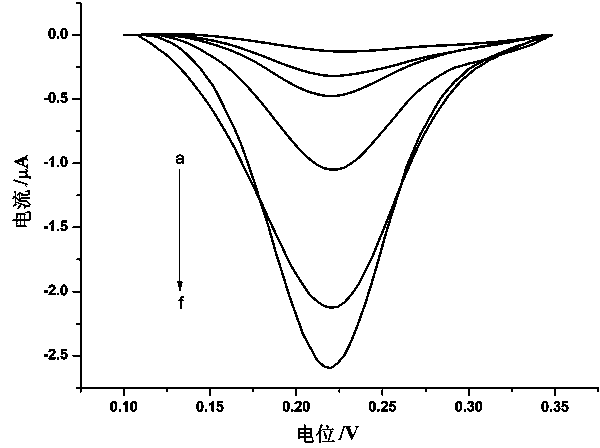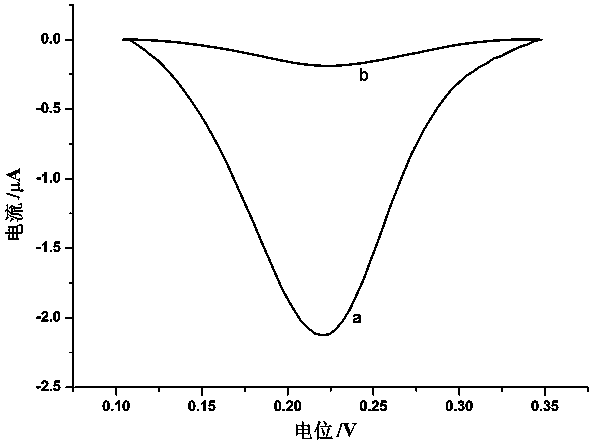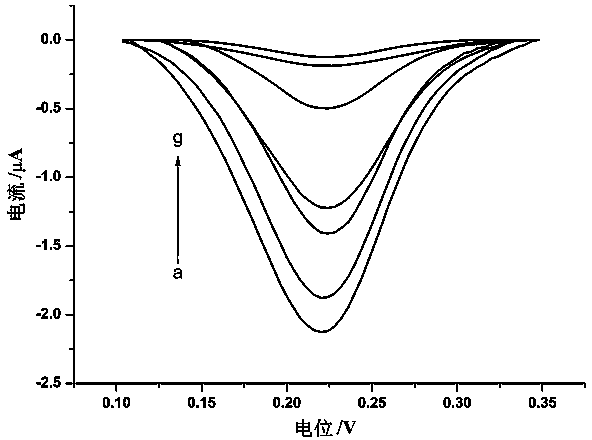An electrochemical biosensor for detecting glutathione and a preparing method thereof
A biosensor, glutathione technology, applied in the direction of material electrochemical variables, scientific instruments, instruments, etc., to achieve the effect of strong affinity, wide application prospects, and sensitive detection
- Summary
- Abstract
- Description
- Claims
- Application Information
AI Technical Summary
Problems solved by technology
Method used
Image
Examples
Embodiment 1
[0027] Example 1: Preparation of double-stranded DNA modified gold electrode
[0028] Drop 20 μL of piranha solution (concentrated sulfuric acid: hydrogen peroxide = 3:1) on the surface of the gold electrode to be treated and react for 2 minutes, rinse with ultrapure water, and blow dry with nitrogen. After polishing the gold electrode on 5000-mesh sandpaper for 5 minutes, it was polished to the mirror surface on the silk containing alumina (grain size of 1 μm, 0.3 μm, 0.05 μm) mortar, and then sonicated in ethanol and ultrapure water. 2 minutes to remove impurities. Place the processed gold electrode at 0.5 M H 2 SO 4 Cyclic voltammetry scan. Set the scan voltage range from 0 to 1.6 V, scan speed 100 mV / s, set 30 cycles to sweep until the cyclic voltammetry curve is stable, and blow dry with nitrogen to obtain a clean surface-treated bare gold electrode, which can be used for modification of sulfhydryl DNA. Immerse the gold electrode in a DNA fixation buffer solution (10 mM Tr...
Embodiment 2
[0029] Example 2: Synthesis and electrochemical quantitative characterization of copper nanoclusters
[0030] Take 40 μL 10 mM ascorbic acid solution and 320 μL reaction buffer (20 mM MOPS, 300 mM NaCl and 2 mM MgCl 2 , PH 7.5) mix, then add 40 μL of copper ion solution of different concentrations to the system, and let stand for 20 minutes. Put the double-stranded DNA modified gold electrode into the above mixed solution and react for 30 minutes at room temperature. After the reaction, the electrode was rinsed with ultrapure water and dried with nitrogen to remove excess copper ions adsorbed on the electrode surface. Subsequently, the electrode was immersed in 200 μL of 0.1 M hydrochloric acid solution to dissolve the copper nanoclusters synthesized on the electrode surface. After 2 hours, the above solution was mixed with 4.8 mL of 0.5 M NaAc-HAc buffer and used as an electrolyte solution for electrochemical detection.
[0031] The relevant nucleic acid sequence is as follows: ...
Embodiment 3
[0036] Example 3: Detection of different concentrations of glutathione
[0037] Take 40 μL 10 mM ascorbic acid solution and 320 μL reaction buffer (20 mM MOPS, 300 mM NaCl and 2 mM MgCl 2 , PH 7.5), and then add 40 μL of 10 μM copper ions and different concentrations of glutathione (0 nM, 1 nM, 5 nM, 10 nM, 100 nM, 1 μM and 10 μM) to the system. Test the mixed solution and react at room temperature for 20 minutes. Subsequently, the double-stranded DNA-modified gold electrode was put into the above-mentioned mixed solution, reacted at room temperature for 30 minutes, and then electrochemical detection was performed. The specific detection steps were the same as those in the second embodiment.
[0038] figure 2 Curve a shows the DPV spectrum obtained by scanning the double-stranded DNA modified gold electrode in a reaction system containing only ascorbic acid and copper ions for a period of time and after a certain treatment. It can be seen that the double-stranded DNA molecules im...
PUM
 Login to View More
Login to View More Abstract
Description
Claims
Application Information
 Login to View More
Login to View More - R&D
- Intellectual Property
- Life Sciences
- Materials
- Tech Scout
- Unparalleled Data Quality
- Higher Quality Content
- 60% Fewer Hallucinations
Browse by: Latest US Patents, China's latest patents, Technical Efficacy Thesaurus, Application Domain, Technology Topic, Popular Technical Reports.
© 2025 PatSnap. All rights reserved.Legal|Privacy policy|Modern Slavery Act Transparency Statement|Sitemap|About US| Contact US: help@patsnap.com



